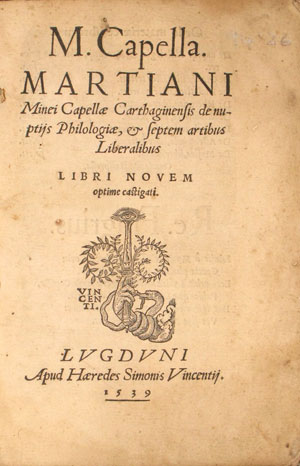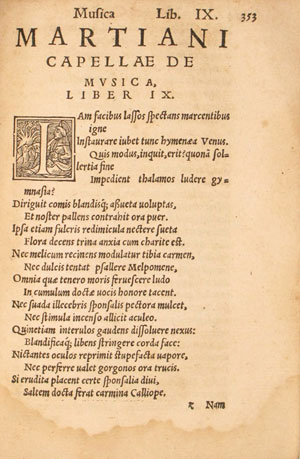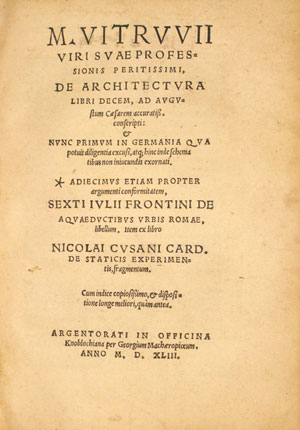Martianus Capella (ca. 5th cent. AD) and Marcus Vitruvius Pollio (ca. 80–70 BC–ca. 15 BC)
Martianus Capella, De nuptijs philologiae et septem artibus liberalibus libri novem optime castigati (Lugduni, 1539)
Born near Carthage in North Africa, the Latin writer Martianus Capella is important for having bequeathed knowledge of ancient Greek music theory through his only known work De Nuptiis Philologiae et Mercurii. The early appearance of this popular didactic work in print editions such as this one fuelled the Renaissance interest in Pythagorean ideas concerning music and its relationship to the so called harmony of the spheres. De Nuptiis Philologiae et Mercurii ('On the Marriage of Philology and Mercury') is an allegorical fantasy in which seven bridesmaids, one for each of the arts, describe the arts they personify.
In his treatment of Music, Martianus Capella drew heavily on the Greek author Aristides Quintilianus (fl 3rd–4th century AD), although a Pythagorean discussion of music also occurs in Arithmetic and Astronomy.
De Nuptiis is also important as one of the earliest instances of the system of the seven liberal arts that from medieval times would structure western education. According to this system, music was grouped together with arithmetic, geometry and astronomy, thereby assuring music's position as a mathematical subject (the remaining three subjects were grammar, logic, and rhetoric).
Vitruvius, De architectvra libri decem (Argentorati, 1543)
As for Martianus Capella, the work of the Roman architect Vitruvius proved important as a conduit for earlier ancient Greek ideas concerning music and universal harmony. Comprising ten books and dedicated to Emperor Augustus, this is both Vitruvius's only known work and the only treatise on architecture to have survived antiquity. Rediscovered in 1414 by the Florentine humanist Poggio Bracciolini, numerous editions published over the subsequent 150 years helped confirm Vitruvius's place as a key source of ancient learning. Music and notions of universal harmony are alluded to at various points throughout the text.
Owing to the fact that Vitruvius's original illustrations had not survived, the woodcuts that occur through this edition are derived from the text. This diagram relates to theatre construction (v.3–9) where a brief summary of Aritoxenian harmonic theory provides the background for a discussion of vases designed to resonate to various musical notes. Vitruvius explained that such vases had served as acoustical enhancements in many theatres in Greece and Italy.
Vitruvius's belief that the proportions of the human body provided a universal model of beauty applicable to architecture was adapted by renaissance architects who proposed a corresponding universal model based on Pythagorean ratios.
The last book of De architectura, in which Vitruvius describes construction of a water organ, was of particular interest to Athanasius Kircher and Gaspar Schott in their discussions of music.




![Diagram explaining the Greek Scale arranged into Tones and Semitones [Hemitones] with Greek note names on the right-hand side](https://www.whipplelib.hps.cam.ac.uk/files/media/23-small_1.jpg)